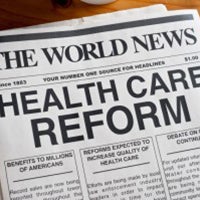
As we continue to struggle with the coronavirus (COVID-19) pandemic, researchers are producing timely studies to help policymakers understand its impact. This May, we explored studies assessing COVID-19’s effect on community health centers (CHCs), data on racial and ethnic disparities in COVID-19 mortality rates, and changes in health spending and utilization during the crisis.
Corallo C and Rolbert J. Impact of Coronavirus on Community Health Centers. Kaiser Family Foundation, May 20, 2020. Community health centers play a vital role by providing free and low-cost care to low-income populations. During the COVID-19 pandemic, CHCs offer testing services and triage patients to avoid overwhelming hospital systems, while continuing to provide behavioral health and primary care. Researchers at the Kaiser Family Foundation analyzed data from a Health Resources and Services Administration survey to understand how CHCs are weathering the pandemic.
What It Finds
- Ninety percent of CHCs across the U.S. are providing COVID-19 tests, with the majority offering walk-up or drive-through testing.
- More than half of all those tested for COVID-19 at CHCs and 56 percent of health centers’ confirmed cases were people of color.
- CHCs reported a 43 percent decrease in overall visits to health centers compared to pre-pandemic volumes.
- Almost 2,000 health center sites have temporarily closed due to COVID-19 (likely an undercount), and 13 states have reported the closures of at least 25 percent of their CHC sites.
- CHCs have received $1.98 billion in emergency federal funding, totaling roughly 7 percent of overall CHC revenue in 2018. Health centers, predominately funded by patient visits, have experienced a 30 percent revenue decrease.
Why It Matters
Community health centers provide invaluable support to underserved communities; 86 percent of CHC patients have household incomes under 151 percent of the federal poverty level, and patients are disproportionately Black and Latino. Research shows that the COVID-19 pandemic is disproportionately affecting Black and Latino communities. Policymakers at the state and federal level should look at ways to ensure CHCs secure adequate funding to address health care needs during the pandemic.
Gross C, et al. Racial and Ethnic Disparities in Population Level Covid-19 Mortality. MedRxiv (Pre-print, not peer reviewed), May 11, 2020. Early on in the COVID-19 pandemic, the dearth of data on infection and mortality rates by race and ethnicity prompted concerns over underreported health disparities. Researchers conducted a cross-sectional study using the reported COVID-19 mortality data to understand age-adjusted disparities as well as the quality of race and ethnicity data available.
What It Finds
- As of April 21, 2020, only 28 states and New York City provided race and ethnicity classifications for COVID-19 mortality, with a wide range of missing race and ethnicity data across states.
- Across all 28 states and New York City, the risk of COVID-19-associated death for Black patients was 3.57 times that of white patients. In Wisconsin, the COVID-19-associated mortality rate of Black patients was 18 times higher than for white patients.
- Latino patients experienced mortality rates 88 percent higher than white patients across all 28 states and New York City.
- The magnitude of COVID-19-related disparities varied widely across states, and the percentage of the population that was Black and Latino, or percent urban, had no association with the level of disparities.
Why It Matters
Health disparities among racial and ethnic minority groups in the United States are nothing new. COVID-19 has exacerbated significant gaps in the health system, further illuminating how institutional, longstanding racism has harmed the Black community in particular. Reporting data on the race and ethnicity of COVID-19 patients and their mortality rate is essential to understanding where disparities exist, and ultimately give us clues to policy interventions that will address the root causes of those disparities.
Cox, C, Kamal R, McDermott D. How have health care utilization and spending changed so far during the coronavirus pandemic? Kaiser Family Foundation, May 29, 2020. Researchers with the Kaiser Family Foundation analyzed data from the Peterson-KFF Health System Tracker to assess how health care utilization and spending have been impacted by the COVID-19 pandemic, social distancing mitigation, and the subsequent economic meltdown.
What It Finds
- Spending across health care services in the first quarter of 2020 (January to March) was roughly level relative to last year, decreasing 0.4 percent compared to the first quarter of 2019.
- Health care expenditures across all services except pharmaceutical drugs were down 38 percent in April 2020 compared to April 2019.
- Spending dropped most significantly for dental services (-61 percent), physician services (-45 percent), and hospital services (-41 percent) between April 2019 and April 2020, while spending increased slightly for nursing homes (+6 percent) and personal consumption spending on prescription drugs (+5 percent).
- While use of telehealth increased sharply in 2020 compared to 2019, virtual visits did not offset decreases in in-person office visits during the pandemic.
- Average weekly volumes of common cancer screenings dropped significantly (86 percent for colon cancer and cervical cancer screenings and 94 percent for breast cancer screenings) between January 20 and April 21, 2020 compared to averages before January 20, 2020.
Why It Matters
Understanding the real costs of the coronavirus can help policymakers respond with funding and other support for struggling sectors of the economy, including the health care sector. While the cost of treating COVID-19 can be high for many patients, providers’ revenue has declined dramatically as elective procedures have been cancelled or delayed. There is likely to be a bumpy road back to treating patients for non-emergency conditions, raising questions about how quickly the health sector will recover. Understanding changes in health spending can help policymakers and other stakeholders understand the widespread impact of COVID-19, predict future costs and pent-up demand for care, and create solutions to ensure better access to essential health services.

